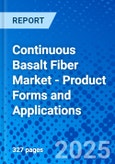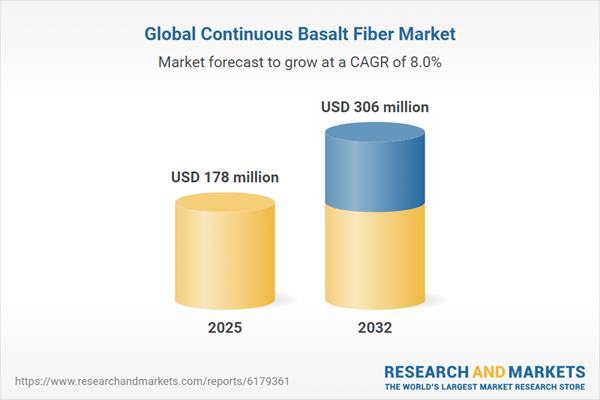The market is transitioning from pilot-scale production toward broader industrial commercialization. Global CBF production capacity is estimated at about 165,000 metric tons per year, with China accounting for nearly two-thirds of total output, followed by Russia, Ukraine, Germany, Belgium, and the UAE. China's growth has been accelerated by domestic technology refinement and large-scale capacity expansions based on early Russian and Ukrainian know-how. Increasing infrastructure development, sustainability initiatives, and replacement of steel and glass reinforcements in corrosive or high-temperature environments are fueling demand. However, widespread adoption remains constrained by factors such as high energy consumption in melting furnaces, variability in basalt composition, and the absence of unified global design standards. The 2022 closure of Mafic USA underscored the commercial challenges for new producers outside Asia and Eastern Europe, while established players such as Kamenny Vek, Isomatex, Technobasalt, and several Chinese firms continue to lead in production consistency and product innovation.
From a competitive standpoint, CBF occupies the middle ground between glass fiber and carbon fiber, offering 20-30% greater tensile strength than E-glass while being more affordable and sustainable than carbon fiber. In 2024, basalt fiber accounted for less than 1% of global composite fiber demand, yet its share is expected to rise steadily through 2031 as cost-performance optimization and green manufacturing incentives drive material substitution. CBF's lower embodied energy, recyclability, and superior resistance to alkali and high-temperature conditions give it a distinct edge in applications such as concrete reinforcement, automotive parts, and composite panels. While glass fibers dominate in volume and carbon fibers in high-end performance, continuous basalt fiber is increasingly positioned as the sustainable, high-strength alternative, bridging performance and affordability across next-generation composite applications worldwide.
Continuous Basalt Fiber (CBF) Regional Market Analysis
In 2025, Asia-Pacific dominated the global continuous basalt fiber market, accounting for 51.6% in value, reflecting the region's strong production base and accelerating adoption in construction, automotive, and industrial applications, particularly in China, where local capacity and composite integration are expanding rapidly. Europe followed as the second-largest regional market, supported by sustainable material mandates, infrastructure renovation projects, and growing use of basalt textiles in transport and defense sectors. On the growth front, Asia-Pacific is projected to remain the fastest-growing region, registering a CAGR of 11.1% in volume and 10.3% in value between 2025 and 2031, driven by industrial scaling, rising composite exports, and government-backed initiatives promoting eco-efficient materials. The Rest of the World region, comprising Latin America, the Middle East & Africa, follows as the second fastest-growing supported by gradual penetration of basalt rebar and fabrics in infrastructure and energy-related applications.Continuous Basalt Fiber (CBF) Market Analysis by Product Form
Basalt rovings represented the largest product form in the global continuous basalt fiber market, with an estimated 64.3% share of total volume. Their dominance reflects widespread use as intermediate reinforcement for fabrics, pultruded profiles, and composite structures across construction and industrial applications. Chopped strands ranked second, supported by their growing role in concrete and polymer reinforcements. Over the forecast period 2025-2031, fabrics are projected to register the fastest growth, expanding at a CAGR of 10.3%, driven by increasing demand for lightweight, fire-resistant textiles in automotive, aerospace, and defense applications.Continuous Basalt Fiber (CBF) Market Analysis by Application
Construction & Infrastructure remain the cornerstone of the global continuous basalt fiber market, accounting for around 52% share in 2025 and projected to reach nearly 38.5 thousand metric tons by 2031, expanding at a CAGR of 8.2%. Demand growth is driven by widespread use of basalt rebar, mesh, and fiber-reinforced composites in bridges, tunnels, and concrete structures offering superior corrosion resistance and durability. Meanwhile, Pipes & Tanks emerge as the fastest-growing segment, posting a 10.5% CAGR, with demand underpinned by basalt composites replacing metal and GRP in corrosive fluid transport systems. Automotive and Transportation sector is emerging as the other fastest growth area, advancing at 10.3% CAGR, fueled by lightweighting initiatives and thermal performance requirements across automotive, marine, and aerospace applications.Continuous Basalt Fiber (CBF) Market Report Scope
This global report on Continuous Basalt Fiber (CBF) market analyzes the global and regional markets based on product form and application for the period 2022-2031 with forecasts from 2025 to 2031 in terms of value in US$. In addition to providing profiles of major companies operating in this space, the latest corporate and industrial developments have been covered to offer a clear panorama of how and where the market is progressing.Key Metrics
- Analysis Period: 2022-2031
- Base Year: 2025
- Forecast Period: 2025-2031
- Units: Volume in Metric Tons and Value market in US$
- Companies Mentioned: 30+
Continuous Basalt Fiber (CBF) Market by Geographic Region
- North America (The United States, Canada)
- Europe (France, Germany, Italy, Russia, the United Kingdom and Rest of Europe)
- Asia-Pacific (China, India, Japan, South Korea and Rest of Asia-Pacific)
- Rest of World (Latin America and Middle-East & Africa)
Continuous Basalt Fiber (CBF) Market by Product Form
- Rovings
- Chopped Strands
- Fabrics
- Other Forms (includes twisted yarns, mats, tapes, tissues etc.)
Continuous Basalt Fiber (CBF) Market by Application
- Construction & Infrastructure
- Automotive & Transportation (including marine and aerospace etc.)
- Electrical & Electronics
- Industrial (includes chemicals and petrochemical industries, manufacturing etc.)
- Pipes & Tanks
- Other Applications (includes sports & leisure, energy, medical prosthetics, robotics etc.)
This product will be delivered within 2-4 business days.
Table of Contents
Companies Mentioned
- ABV Holding LLC
- Arab Basalt Fiber Company
- ArmBasalt CJSC (ARMBAS)
- ASA.TEC GmbH (CARBON Group)
- Basalt Fibers (Georgia)
- Basalt Uzbekistan
- Basaltex NV
- China Beihai Fiberglass Co., Ltd.
- Chongqing Hesheng Longgang Technology Co. Ltd.
- Chongqing Zhidu New Material Technology Co., Ltd.
- Deutsche Basalt Faser GmbH
- Guizhou Shixin Basalt Technology Co., Ltd.
- Hengdian GBF Basalt Fiber Co., Ltd.
- Huabin General Machinery & Equipment Import & Export Co, Ltd.
- Isomatex S.A.
- Jiangsu Tianlong Basalt Continuous Fiber Co., Ltd.
- Jilin Huayang New Composite Materials Co., Ltd.
- Jilin Tongxin Basalt Technology Co. Ltd.
- JSC "Polotsk-Steklovolokno"
- Kamenny Vek
- LAVAintel CJSC
- Mineral 7 (fiberbas)
- Polski Bazalt SA
- Rock Fiber Inc.
- Russkiy Bazalt OOO
- Shanxi Yaxin Energy Group Co., Ltd.
- Sichuan Aerospace Tuoxin Basalt Industrial Co., Ltd
- Sichuan Fiberglass Group Co., Ltd.
- Sichuan Jumeisheng New Material Technology Co., Ltd
- Sichuan Qianyi Composite Naterial Co., Ltd.
- Sichuan Torch Original (Juyuan) Basalt Fiber Technology Co., Ltd.
- Technobasalt Invest LLC
- Ukrainian Basalt Technology LLC (UBT)
Table Information
| Report Attribute | Details |
|---|---|
| No. of Pages | 327 |
| Published | October 2025 |
| Forecast Period | 2025 - 2032 |
| Estimated Market Value ( USD | $ 178 million |
| Forecasted Market Value ( USD | $ 306 million |
| Compound Annual Growth Rate | 8.0% |
| Regions Covered | Global |
| No. of Companies Mentioned | 33 |









